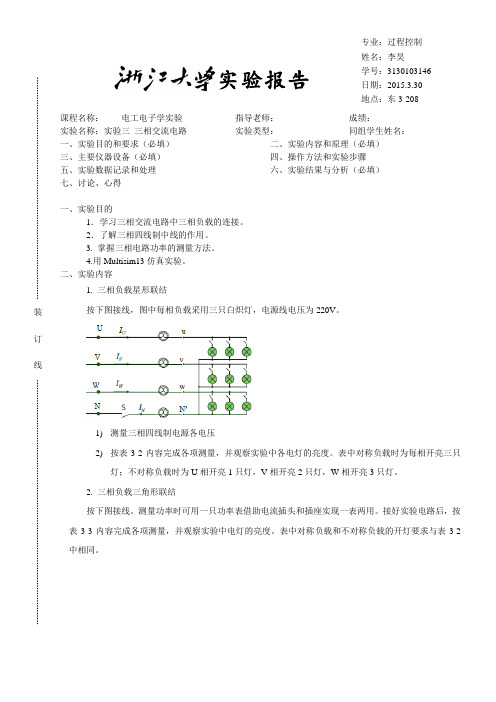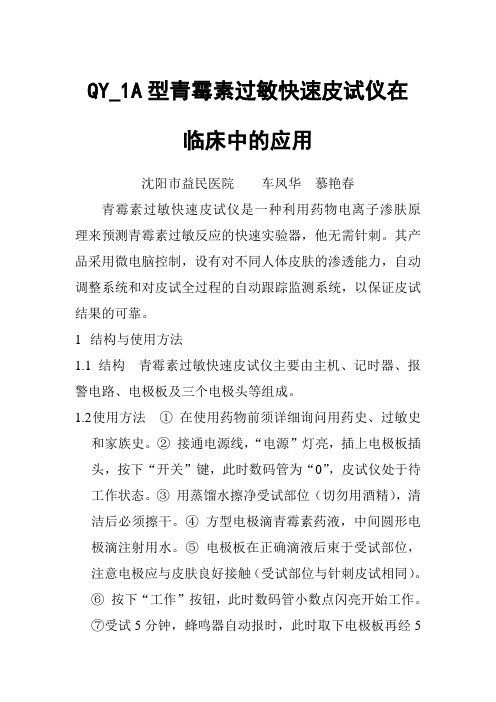icsy1_1实验报告截图
- 格式:doc
- 大小:276.50 KB
- 文档页数:4

实验报告课程名称: 电工电子学实验 指导老师:________________成绩:__________________ 实验名称:实验三 三相交流电路 实验类型:________________同组学生姓名:__________ 一、实验目的和要求(必填) 二、实验内容和原理(必填) 三、主要仪器设备(必填) 四、操作方法和实验步骤 五、实验数据记录和处理 六、实验结果与分析(必填) 七、讨论、心得一、实验目的1.学习三相交流电路中三相负载的连接。
2.了解三相四线制中线的作用。
3. 掌握三相电路功率的测量方法。
4.用Multisim13仿真实验。
二、实验内容1. 三相负载星形联结按下图接线,图中每相负载采用三只白炽灯,电源线电压为220V 。
1) 测量三相四线制电源各电压2) 按表3-2内容完成各项测量,并观察实验中各电灯的亮度。
表中对称负载时为每相开亮三只灯;不对称负载时为U 相开亮1只灯,V 相开亮2只灯,W 相开亮3只灯。
2. 三相负载三角形联结按下图接线。
测量功率时可用一只功率表借助电流插头和插座实现一表两用。
接好实验电路后,按表3-3内容完成各项测量,并观察实验中电灯的亮度。
表中对称负载和不对称负载的开灯要求与表3-2中相同。
专业:过程控制 姓名:李昊学号:3130103146 日期:2015.3.30 地点:东3-2081. 实验电路板2. 三相交流电源(220V )3. 交流电压表或万用表4. 交流电流表5. 功率表6. 单掷刀开关7. 电流插头、插座 四、实验数据的记录与处理 数据记录 表3-1 表3-2 表3-3五、实验结果1. 由数据可得线电压是相电压的根号3倍,三角形联结时相电流是线电流的根号3倍。
2.3.P(对称)=215.4 P(不对称)=147.0。




QY_1A型青霉素过敏快速皮试仪在临床中的应用沈阳市益民医院车凤华慕艳春青霉素过敏快速皮试仪是一种利用药物电离子渗肤原理来预测青霉素过敏反应的快速实验器,他无需针刺。
其产品采用微电脑控制,设有对不同人体皮肤的渗透能力,自动调整系统和对皮试全过程的自动跟踪监测系统,以保证皮试结果的可靠。
1结构与使用方法1.1 结构青霉素过敏快速皮试仪主要由主机、记时器、报警电路、电极板及三个电极头等组成。
使用方法①在使用药物前须详细询问用药史、过敏史和家族史。
②接通电源线,“电源”灯亮,插上电极板插头,按下“开关”键,此时数码管为“0”,皮试仪处于待工作状态。
③用蒸馏水擦净受试部位(切勿用酒精),清洁后必须擦干。
④方型电极滴青霉素药液,中间圆形电极滴注射用水。
⑤电极板在正确滴液后束于受试部位,注意电极应与皮肤良好接触(受试部位与针刺皮试相同)。
⑥按下“工作”按钮,此时数码管小数点闪亮开始工作。
⑦受试5分钟,蜂鸣器自动报时,此时取下电极板再经5分钟后观察皮肤反应情况,按下“复零”按钮,皮试仪处于待工作状态。
2受试结果判别2.1 阴性征象:①试验始终、试验处或全身无任何感觉。
②试验处三个压迹内外皮肤色泽情况相同。
2.2 阳性征象:①试验处有痒、刺、压、麻感觉。
②全身反应:指青霉素所特有的反应体征。
3皮试药液的配制方法青霉素皮试液浓度为10000单位/毫升。
4临床应用效果我院自2002年7月引进了QY—1A型青霉素过敏快速皮试仪,在门(急)诊和儿科投入使用。
年龄小到几个月的婴儿,大至70—80岁的老人。
三年来累计做了7100余例,无一例出现过敏反应。
同时采用了注射用水与皮试液同时做的对照方法,减少了皮试的阳性率。
比针刺皮试操作简单、方便、安全、快速且无痛,其皮试的费用与针刺皮试的费用相同,患者易于接受。
对前来就诊患者需做皮试时,皮试仪的利用率达100%。
提高了工作效率;消除了患者的恐惧心理;减少患者的痛苦,尤其是患儿。

NY―1型高压毛细管式粘度计的工作原理与测试结果的数据处理Introduction:NY-1 High-pressure Capillary Viscometer is an instrument used for measuring the viscosity of fluids under high pressure. The instrument is used to measure the flow resistance of the fluid passing through a capillary tube in order to derive the fluid’s viscosity. This paper aims to highlight the working principle of NY-1 high-pressure capillary viscometer and the process of data analysis of test results.Working Principle:The NY-1 High-pressure Capillary Viscometer consists of a capillary tube with a diameter of 0.1 to 1 mm that is connected with a pump, a pressure gauge, and a temperature control system. The fluid whose viscosity needs to be measured is pumped into the capillary tube, which has a precisely controlled pressure of up to 135Mpa. The pressure drop across the capillary volume is then measured, allowing the calculation of the viscosity of the fluid.Data Analysis:The NY-1 High-pressure Capillary Viscometer measures the viscosity of fluids under high pressure, and hence the data analysis process is a critical aspect of the test procedure. The following steps are involved in analyzing the data obtained from the instrument:1. Calculation of Viscosity:The viscosity of the fluid is calculated using the Hagen-Poiseuille equation, which relates the pressure drop across the capillary tube to the viscosity of the fluid. The equation is as follows:η = 128QμL/πr^4Pwhere, η is the viscosity, Q is the flow rate, μ is the fluid density, L is the length of the capillary tube, r is the radius of the capillary tube, and P is the pressure drop across the capillary tube.2. Calibration of the Instrument:Before using the instrument for measuring the viscosity of a fluid, it is essential to calibrate the instrument by measuring the viscosity of a standard fluid. This calibration step ensures that the instrument is accurate and produces reliable data.3. Data Processing:After the viscosity of the fluid has been measured, the data obtained is processed. The data obtained from the NY-1 High-pressure Capillary Viscometer is in the form of pressure drop vs. flow rate graph. The graph is used to derive the viscosity of the fluid using the Hagen-Poiseuille equation. The data processing includes averaging the data, calculating the uncertainty in the data, and plotting the data on a graph.Conclusion:The NY-1 High-pressure Capillary Viscometer is an instrument widely used in the oil and gas industry. The instrument’s working principle involves measuring the flow resistance of fluids passing through a capillary tube to derive the fluid’s viscosity. The data obtained from the instrument needs to be analyzed, including the calculation of viscosity, calibration of the instrument, and data processing. By following these steps, reliable data can be obtained, and hence the accurate measurement of fluid viscosity under high pressure can be achieved.Apart from the basic working principle and data analysis, there are several other factors that impact the measurement of viscosity using NY-1 High-pressure Capillary Viscometer. Some of these factors include temperature control, fluid composition, and capillary tube material.Temperature plays a critical role in determining the viscosity of a fluid. As temperature increases, viscosity tends to decrease, and as temperature decreases, viscosity increases. Hence, it is essential to control the temperature of the fluid during the measurement process to prevent inaccurate results. NY-1 High-pressure Capillary Viscometer comes with a temperature control system to maintain a constant temperature throughout the measurement process.The composition of the fluid also influences the viscosity measurement. Non-Newtonian fluids, such as polymers, behave differently from Newtonian fluids like water. Non-Newtonian fluids exhibit different viscosity values at different flow rates, and their viscosity may vary depending on the shear rate or force applied. Hence, for such fluids, it might be necessary to measuretheir viscosity at different shear rates or forces.Capillary tube material and dimensions also affect the measurement results. The dimensions of the capillary tube, such as length and diameter, determine the flow rate and pressure drop across the capillary. The material of the capillary tube must also be inert to the fluid being measured to prevent interactions that can impact the viscosity readings.In conclusion, the NY-1 High-pressure Capillary Viscometer is a crucial instrument used to measure fluid viscosity under high pressure. To obtain precise and reliable results, it is essential to consider factors such as temperature, fluid composition, and capillary tube material and dimensions. With proper use, the NY-1 High-pressure Capillary Viscometer proves to be a valuable tool in the oil and gas industry, enabling researchers to gain valuable insights into the viscosity and flow behavior of fluids under high-pressure environments.Another important factor that can impact the measurement of viscosity using the NY-1 High-pressure Capillary Viscometer is the accuracy of the instrumentation. The device itself must be calibrated periodically and kept in good condition to ensure the accuracy of the measured values.The operator's technique and experience can also affect the measurement outcome. The operator must ensure that the capillary tube is properly loaded and free of air bubbles, which can interfere with the measurement process. In addition, the operator should take care to follow the manufacturer's instructions and use appropriate safety measures.Environmental factors, such as humidity and air pressure, can also impact viscosity measurements. An increase in humidity can cause the fluid to absorb moisture, leading to a change in viscosity. Changes in air pressure can also cause fluid density and viscosity to shift. Therefore, humidity and air pressure must be monitored and controlled for accurate viscosity measurements.Finally, the time required for the measurement process can vary depending on the type of fluid and the required accuracy. For instance, some measurements may need to be taken over an extended period to obtain a reliable value. In other cases, short measurements may be sufficient to obtain accurate results.In conclusion, the viscosity measurement using the NY-1 High-pressure Capillary Viscometer is a complex process that requires careful consideration of various factors. To obtain reliable and accurate measurements, researchers should pay attention to factors such as fluid composition, temperature, capillary tube material and dimensions, instrumentation accuracy, operator technique, environmental factors, and measurement duration. By taking these factors into account, researchers can obtain valuable insights into fluid behavior and better understand the complexities of high-pressure environments.Another important factor to consider when using the NY-1 High-pressure Capillary Viscometer is the shear rate. This is the rate at which the fluid is sheared as it passes through the capillary tube. Shear rate can influence the fluid's viscosity, and should be taken into account during viscosity measurements.It is also important to consider any non-Newtonian behavior of thefluid being measured. Non-Newtonian fluids exhibit properties that can impact viscosity, such as shear-thinning or shear-thickening behavior. Such behavior can lead to errors if not properly accounted for during viscosity measurements.The temperature control of the fluid is another important factor to consider when measuring viscosity using the NY-1 High-pressure Capillary Viscometer. Temperature can significantly impact fluid viscosity, and the temperature should be closely monitored and controlled to obtain reliable results.Additionally, the material and dimensions of the capillary tube can affect the measurement outcome. Ideally, the capillary tube should be made of a material that is inert to the fluid being measured and should have a diameter that is appropriate for the fluid being tested. If the capillary tube is too narrow or too wide, it can impact the measurement outcome.In high-pressure environments, the viscosity of the fluid can change significantly. Therefore, it is important to consider the effect of pressure on the viscosity measurement using the NY-1 High-pressure Capillary Viscometer.Finally, it is important to use appropriate data analysis techniques to obtain reliable and accurate viscosity measurements. The data obtained should be analyzed using appropriate statistical methods to identify any significant trends or discrepancies. Taking into account all of these factors can help ensure the accurate measurement of viscosity using the NY-1 High-pressure Capillary Viscometer, providing valuable insights into fluid behavior inhigh-pressure environments.Yes, that is correct! Considering all of these factors can help ensure accurate and reliable viscosity measurements using the NY-1 High-pressure Capillary Viscometer, which is essential for gaining valuable insights into fluid behavior in high-pressure environments.。
实验报告生物医学电子学实验一 生物电前置放大器一、实验目的了解三运放生物电前置放大器设计原理,掌握放大器的设计、调试和测量方法,熟悉protel 软件。
二、实验原理及说明1. 应用场合放大器的设计一般采用定性分析、定量估算、实验调整结合的方法。
在设计过程中,首先根据使用要求选择放大器的放大倍数、放大器的级数和放大器的电路形式,计算确定各个电阻元件的取值,然后连接电路并实际测量放大器的各项参数,根据测量结果对电路进行适当调整,以满足具体设计要求。
2. 工作原理人体体表心电信号的幅值约为1-2mV ,要求放大器的总放大倍数为40倍。
本实验采用三运放差动放大器,电路形式如下图所示。
设计时,要按照所给定的电路形式,分配各级放大器的放大倍数,然后根据放大倍数计算出放大电路中各个电阻的阻值。
3. 原理图三、实验内容与步骤l. 元件值设定根据教材相关内容和实验原理,设定合适的电阻等元件值。
2. 建立仿真电路图熟悉protel 软件,按照图中所示,选择LM348作为运算放大器,建立仿真电路图。
3. 电路参数调试(1) 静态工作点:将放大器两输入端对地短路,观察各级放大器输出波形并记录u o幅值,若各个输出端均小于0.5V 即为合格。
(2) 差模增益:将20Hz ,1mv 的正弦信号接到放大器的一个输入端而另一端接地,观察输出波形od V ,并记录。
计算差模增益:ViV A odd =。
(3) 共模增益:将放大器两输入端共同接2V/50Hz 的正弦信号,观察输出波形并记录oc V 的幅值,计算共模增益ViV A occ =。
(4) 计算共模抑制比:)( lgdB A A 20CMRR cd=四、实验要求认真阅读实验原理及说明,理解生物电前置放大的基本原理,独立完成实验,总结分析实验结果,写出完整的实验报告,熟悉protel软件的使用。
实验二 RC 有源滤波器一、实验目的1. 通过实验,熟悉由运放组成RC 有源滤波器的工作原理。